
How to Care for Your Miniature Japanese Maple Tree: Expert Tips for Thriving Growth
Looking for a stunning tree that adds elegance to small spaces? A miniature Japanese maple tree might be the perfect solution! 
In this expert guide, we’ll cover all the essential tips you need to help your miniature Japanese maple tree grow strong, healthy, and vibrant. Keep reading to discover how to give your tree the best care and enjoy its beauty for years to come!
Table of Contents
ToggleWhy Choose a Miniature Japanese Maple Tree?
Miniature Japanese Maple trees are a perfect choice for anyone looking to add beauty, elegance, and a touch of nature to their home or garden. Whether you’re a seasoned gardener or a beginner, these stunning trees offer a variety of benefits that make them a popular choice for many. Here’s why you should consider adding one to your space:
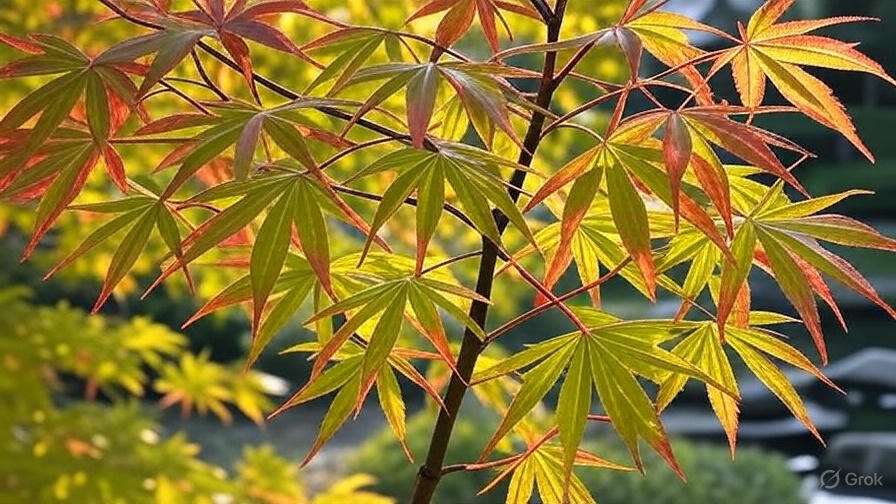
1. Compact Size for Any Space 
Miniature Japanese Maples are ideal for small gardens, patios, or even indoor spaces. Their compact size allows them to fit in places where larger trees wouldn’t, making them perfect for urban dwellers or people with limited outdoor space. Whether you have a tiny balcony or a cozy apartment, a miniature maple can thrive without overwhelming your space.
2. Year-Round Beauty 

These trees aren’t just beautiful in one season—they’re stunning year-round! In spring and summer, they boast vibrant green or red foliage. Come fall, they transform into a brilliant display of gold, orange, and red hues. Even in winter, their graceful, bare branches add an elegant touch to your garden or home. This seasonal beauty keeps your space lively and colorful throughout the year.
3. Low Maintenance, High Reward 
Miniature Japanese Maples are relatively low-maintenance compared to other trees. They thrive in well-drained soil and partial shade, making them easy to care for. With a little watering, occasional pruning, and proper placement, these trees will reward you with gorgeous foliage and a serene atmosphere. Perfect for busy people who still want to enjoy a beautiful, low-maintenance plant!
4. Unique Aesthetic Appeal 
The delicate, finely-textured leaves of the Japanese Maple tree create a soft, graceful aesthetic that’s perfect for adding an elegant touch to your garden, patio, or home. Their stunning leaf shapes and colors add visual interest, whether you’re creating a traditional Japanese garden or simply want a tree that stands out.
5. Perfect for Bonsai Lovers 
If you’ve ever wanted to try your hand at bonsai, a miniature Japanese Maple is an excellent choice. Its small size and delicate growth make it an ideal tree for bonsai cultivation, allowing you to shape and style it into a beautiful miniature tree. Plus, the natural beauty of the tree’s leaves adds to its charm when pruned into a bonsai shape.
6. Great for All Skill Levels 
Whether you’re a beginner or an experienced gardener, a miniature Japanese Maple is a tree that everyone can enjoy. Its forgiving nature makes it easy to grow in various environments, and it adapts well to a range of growing conditions. This tree can be a rewarding experience for anyone who loves nature, no matter their gardening expertise.
By choosing a Miniature Japanese Maple tree, you’re not only adding a beautiful plant to your space but also introducing a symbol of peace, longevity, and natural elegance. It’s a tree that brings joy throughout the year, no matter where you live.
Understanding the Growing Needs of Your Miniature Japanese Maple Tree 
Miniature Japanese Maple trees are a stunning addition to any garden, but they come with specific care needs that must be met to thrive. Understanding these needs is key to ensuring your tree flourishes. Here’s a breakdown of what your miniature Japanese Maple requires for healthy, vibrant growth:
1. Proper Sunlight Exposure 
Miniature Japanese Maples need just the right amount of sunlight. While they can tolerate some shade, they do best when they receive 4-6 hours of direct sunlight each day. Morning sun is ideal, as it’s gentle and helps keep the tree cool in the afternoon heat. Too much harsh afternoon sun can scorch their delicate leaves, so if you live in a hot climate, consider placing your tree in partial shade during the hottest parts of the day.
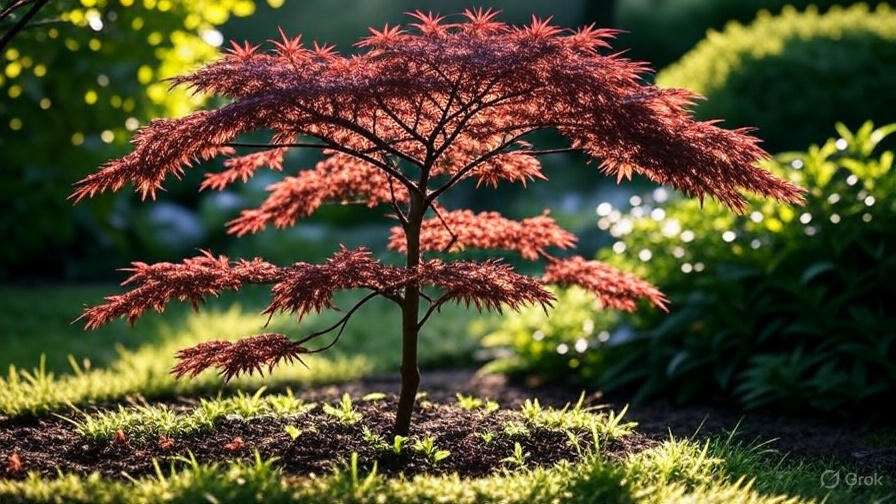
2. Consistent Watering 
Watering is one of the most important aspects of caring for your miniature Japanese Maple. These trees prefer moist, well-draining soil. Be sure to water your tree regularly, especially during the growing season, but avoid letting the roots sit in standing water. Overwatering can lead to root rot, so ensure the pot or ground soil drains well.
A good rule of thumb is to water when the top inch of soil feels dry. During winter, you can reduce watering, but make sure the soil doesn’t dry out completely.
3. Well-Draining Soil 
Japanese Maples do best in well-draining, slightly acidic soil. If the soil retains too much water, the roots can suffocate, which affects the tree’s health. A mixture of loamy soil with organic matter is ideal. If you’re planting in a pot, make sure there are drainage holes to allow excess water to escape.
4. Temperature and Humidity 
These trees thrive in mild climates, with temperatures ranging from 60°F to 75°F (15°C to 24°C). They are not frost-tolerant, so if you live in an area with harsh winters, consider bringing your miniature Japanese Maple indoors or providing winter protection.
Humidity also plays a role in their well-being. If you live in a dry climate, you may need to increase humidity around the tree, especially during hot months. A simple way to do this is by placing a humidifier nearby or setting your tree on a shallow tray of water filled with pebbles.
5. Fertilization 
Fertilizing your miniature Japanese Maple helps promote healthy growth, but it’s important not to overdo it. Use a slow-release, balanced fertilizer in early spring and again in late summer. Avoid fertilizing in late fall or winter when the tree is dormant. Over-fertilizing can burn the roots or cause excessive, weak growth.
6. Pruning and Maintenance 
To maintain the tree’s shape and health, prune dead or damaged branches in late winter or early spring before new growth begins. You can also trim branches that are crossing each other or growing too close to the center, which improves airflow and sunlight penetration. Always use sharp, clean pruning shears to avoid damaging the tree.
7. Protection from Pests and Diseases 
Miniature Japanese Maples are generally hardy, but they can be susceptible to certain pests and diseases. Aphids, scale insects, and spider mites may target the leaves, so keep an eye out for any unusual spots or discoloration. You can treat infestations with an insecticidal soap or neem oil. Fungal infections like powdery mildew can also occur, especially in humid conditions, so be sure to maintain good air circulation around your tree.
By understanding and addressing these key care factors, you’ll help your miniature Japanese Maple grow strong, healthy, and beautiful for years to come.
Planting Your Miniature Japanese Maple Tree 
Planting your miniature Japanese maple tree is the first step to ensuring it grows strong and beautiful. Whether you’re planting in a container or directly in your garden, proper planting is key to its long-term health. Follow these simple steps for a successful planting experience!
1. Choose the Right Location 
Miniature Japanese maples thrive in partial shade to full sunlight. However, too much direct sunlight can cause leaf scorch, so avoid locations where the tree will be exposed to intense midday sun. A spot with morning sunlight and afternoon shade is ideal. Make sure your location has good airflow, as this helps prevent fungal diseases.
2. Prepare the Soil 
Your tree needs well-draining soil to prevent root rot. If planting in the ground, amend the soil with organic matter, like compost, to improve drainage. For container planting, choose a high-quality potting mix that allows water to flow freely. Japanese maples prefer slightly acidic to neutral soil (pH 5.5 to 7.0).

3. Dig the Right Hole 
When planting in the ground, dig a hole that is at least twice as wide and deep as the root ball. This gives the roots plenty of room to spread out. For containers, choose a pot that is about 1.5 to 2 times the size of the root ball. Ensure there are drainage holes in the bottom of the pot to prevent water from collecting.
4. Handle the Roots Gently 
Carefully remove your tree from its pot or packaging. Avoid disturbing the roots too much—Japanese maples are sensitive to root damage. If the roots are circling the root ball, gently tease them apart to encourage outward growth. Place the tree in the hole or pot, ensuring the root ball is level with the surrounding soil.
5. Water Thoroughly 
Once your tree is in place, water generously to settle the soil around the roots. Make sure the soil is evenly moist but not waterlogged. Japanese maples do not like sitting in soggy soil, so ensure the area has good drainage.
6. Mulch for Moisture Retention 
Apply a layer of mulch around the base of your tree, about 2-3 inches deep. Mulch helps retain moisture, regulates soil temperature, and keeps weeds at bay. Be sure to keep the mulch a few inches away from the tree trunk to avoid rot.
7. Monitor After Planting 
Keep a close eye on your miniature Japanese maple in the first few weeks after planting. Check the soil moisture regularly—if it starts to dry out, water again. However, don’t overwater, as the roots need to breathe. Watch for signs of stress, like wilting or yellowing leaves, and address any issues promptly.
By following these simple steps, your miniature Japanese maple will be on its way to thriving and enhancing your garden or home. 
Ongoing Care for a Healthy Miniature Japanese Maple Tree 
Caring for a miniature Japanese Maple tree goes beyond the initial planting. To keep your tree healthy and thriving year-round, follow these practical tips:
1. Watering the Right Way 
Watering is crucial for your miniature Japanese Maple’s health. Aim to keep the soil consistently moist, but not soggy. Water deeply when the top 1-2 inches of soil feel dry. In hot weather, your tree may need extra water, but always ensure the soil drains well to avoid root rot.
Pro Tip: Water in the early morning to reduce evaporation and prevent fungal diseases.
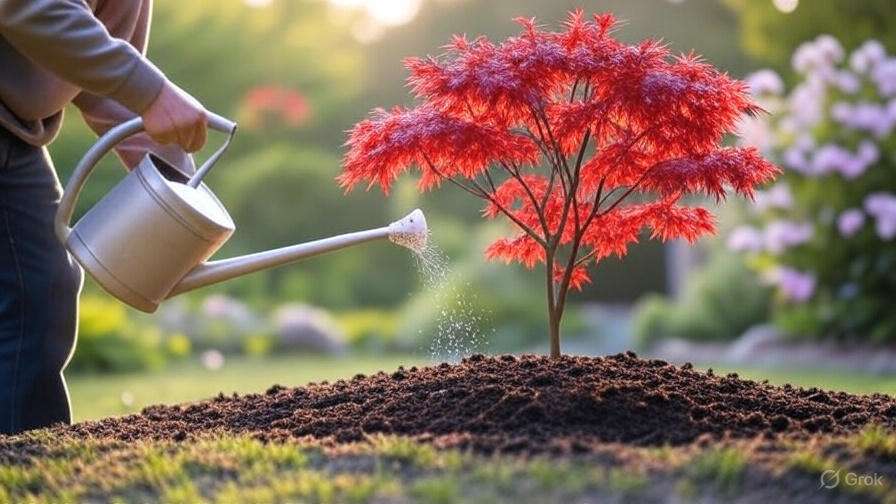
2. Sunlight Requirements 
Miniature Japanese Maples thrive in partial shade. Too much direct sunlight can scorch their delicate leaves, while too little sunlight can stunt their growth. Aim for about 4-6 hours of indirect sunlight daily. If you live in a hot climate, provide some afternoon shade to protect your tree.
3. Feeding for Optimal Growth 
Fertilizing your tree is key to encouraging vibrant leaves and healthy growth. Use a balanced, slow-release fertilizer in spring, just before new growth starts. Avoid over-fertilizing, as this can lead to excessive, weak growth. Feed your tree once or twice a year, in early spring and again in late summer.
4. Pruning for Shape 
Regular pruning helps maintain the tree’s shape and encourages air circulation. Trim dead or damaged branches, and remove any crowded areas to allow the tree to breathe. Early spring, before new growth starts, is the best time to prune. Be gentle with your cuts to avoid stressing the tree.
Pro Tip: Remove crossing branches to improve the overall structure and prevent damage in windy conditions.
5. Protecting from Pests and Diseases 
Although miniature Japanese Maples are relatively resistant to pests, they can still fall victim to aphids, scale insects, or fungal issues. Regularly inspect the leaves, stems, and soil for any signs of pests or disease. If you spot any, treat the tree promptly with an organic insecticide or fungicide.
6. Winter Care 
During winter, miniature Japanese Maples can be vulnerable to frost damage. If you live in an area with cold winters, consider wrapping the tree in burlap or moving it to a sheltered location. Mulching around the base will help protect the roots from freezing temperatures.
7. Repotting and Pot Care 
If your tree is in a container, repot it every 2-3 years to ensure the roots have enough space to grow. Choose a pot that’s only slightly larger than the current one, and make sure it has good drainage. Refresh the soil with each repotting to provide fresh nutrients.
By following these simple yet effective care tips, you can keep your miniature Japanese Maple tree thriving and vibrant throughout the seasons. 
Seasonal Care for Your Miniature Japanese Maple Tree 
Caring for your miniature Japanese maple tree throughout the seasons is key to ensuring its long-term health and beauty. Each season brings its own set of challenges and care requirements, but don’t worry—these simple, expert tips will help your tree thrive year-round.

Spring  : Time to Wake Up
: Time to Wake Up
Spring is a time of renewal for your miniature Japanese maple. As the weather warms up, your tree will start showing new growth. Here’s how to help it along:
- Watering: With the increase in temperature and sunlight, your tree will need more water. Make sure the soil is kept consistently moist but not soggy. A good rule of thumb is to water when the top inch of soil feels dry to the touch.
- Fertilizing: Apply a balanced, slow-release fertilizer once the new growth begins. This helps support healthy leaves and vibrant color.
- Pruning: Lightly prune any dead or damaged branches to encourage strong, new growth. Be gentle—over-pruning can stress the tree.
Summer  : Keep It Cool and Hydrated
: Keep It Cool and Hydrated
Summer heat can be hard on a miniature Japanese maple, especially if it’s planted in a container or receives direct sunlight. Keep these tips in mind:
- Watering: Hot temperatures mean your tree will need more water. Water deeply and frequently, especially on hot days. Ensure the soil drains well to avoid root rot.
- Shade: Protect your tree from the harsh afternoon sun, which can scorch its delicate leaves. A spot with morning sun and afternoon shade is ideal.
- Humidity: Japanese maples prefer higher humidity, so consider placing your tree on a humidity tray or near a water source to keep the air moist.
Fall  : A Time for Transition
: A Time for Transition
As the weather cools and the leaves begin to change color, your miniature Japanese maple starts preparing for dormancy. Here’s how to assist the transition:
- Watering: Reduce watering slightly as temperatures drop. The tree will use less water as it prepares to rest.
- Fertilizing: Stop fertilizing in late fall, as the tree won’t be actively growing anymore. Fertilizing too late can encourage new growth that may not survive the winter.
- Leaf Cleanup: Once the leaves start to fall, remove them from the base of the tree. Dead leaves can harbor pests or diseases.
Winter  : Keep It Safe and Resting
: Keep It Safe and Resting
Winter is the time when your miniature Japanese maple goes dormant, but it still needs protection. Here’s how to help it stay safe and healthy during the cold months:
- Watering: While the tree is dormant, it still needs occasional watering. If the soil is dry, give it a light watering to keep the roots from drying out completely.
- Protection from Frost: If you live in a region with freezing temperatures, consider moving your tree to a more sheltered spot, such as a garage or shed, to protect it from harsh frost. If it’s in a pot, consider wrapping the container with burlap or insulation material to keep the roots warm.
- Pruning: Winter is a good time for heavier pruning, as the tree is dormant and won’t suffer from stress. Remove any dead or diseased branches to promote healthier growth in the spring.
By following these simple seasonal care tips, your miniature Japanese maple tree will thrive year after year, delighting you with its stunning beauty and graceful form.
Common Problems and Solutions for Miniature Japanese Maple Trees 
Miniature Japanese maples are beautiful and delicate, but like all plants, they can face some challenges. Here are the most common problems you might encounter and easy solutions to help keep your tree thriving.
1. Leaf Burn from Sun Exposure 
Problem: Miniature Japanese maples have delicate leaves that can easily get sunburned, especially if they’re exposed to direct midday sun.
Solution: Provide your tree with partial shade, particularly during the hottest part of the day. A spot with morning sun and afternoon shade is ideal. If your tree is in a pot, consider moving it to a more sheltered location during peak heat.
2. Yellowing Leaves (Chlorosis) 
Problem: If your tree’s leaves are turning yellow, it could be a sign of poor soil drainage, overwatering, or a lack of nutrients.
Solution: Check the soil’s drainage to ensure excess water isn’t sitting around the roots. If necessary, repot your tree in well-draining soil. Make sure you’re not overwatering—allow the soil to dry out a bit between waterings. You can also add a slow-release fertilizer to give it the nutrients it needs.
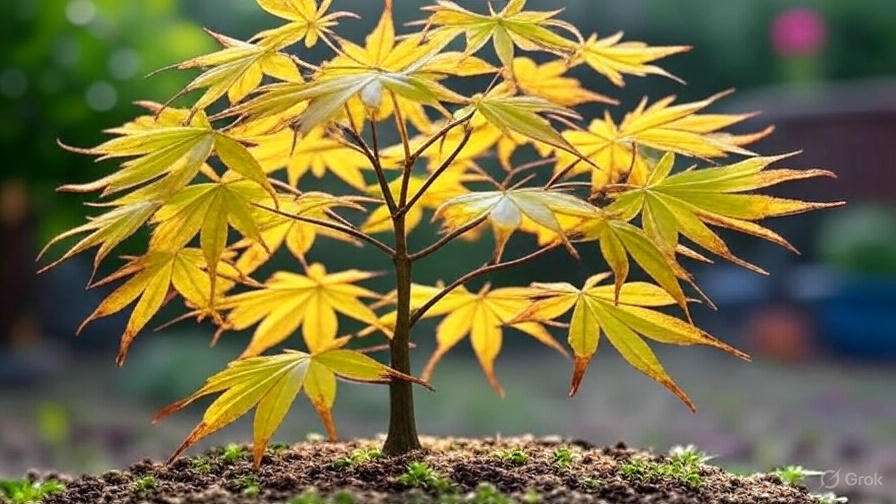
3. Leaf Drop or Browning Edges 
Problem: Brown, crispy edges or premature leaf drop can be a sign of stress due to underwatering, pest issues, or extreme weather conditions.
Solution: Water your tree regularly, but avoid soggy soil. Check for pests like aphids or spider mites, which can damage leaves. During extreme heat or frost, consider moving your tree to a more protected location to shield it from the harsh weather.
4. Stunted Growth or Leggy Appearance 
Problem: If your tree isn’t growing as expected or has become leggy (long, spindly branches), it could be due to poor light or a lack of pruning.
Solution: Ensure your tree is getting the right amount of light. While it doesn’t need full sun, it still requires bright, indirect light. Prune dead or leggy branches to encourage fuller growth and maintain its compact shape.
5. Root Rot 
Problem: Overwatering is a leading cause of root rot. When the roots stay too wet for too long, they begin to decay, affecting the health of the tree.
Solution: Always check the soil before watering. If it feels moist to the touch, wait a day or two before watering again. If you suspect root rot, gently remove the tree from its pot and check the roots. Trim any blackened, mushy roots and repot the tree in fresh, well-draining soil.
6. Pests and Diseases 
Problem: Aphids, scale, and fungal diseases can be a threat to your miniature Japanese maple, affecting its overall health.
Solution: Regularly inspect the leaves and branches for signs of pests. If you notice tiny bugs or sticky residue, use an insecticidal soap or neem oil to treat your tree. For fungal issues, make sure your tree has proper air circulation, and remove any infected leaves. If necessary, use a fungicide specifically designed for Japanese maples.
7. Improper Pot Size 
Problem: A tree in a pot that’s too small or too large can suffer from poor root development or water stress.
Solution: When choosing a pot, make sure it’s only slightly larger than the root ball. A pot that’s too large will hold excess moisture, leading to root rot, while a pot that’s too small will restrict growth. Repot every couple of years to ensure your tree has room to grow.
8. Fall Color Not Appearing 
Problem: Some miniature Japanese maples fail to show their stunning fall colors if they’re stressed or not getting the right conditions.
Solution: Ensure your tree is in a spot with the right balance of light and moisture. Stress from over or underwatering, poor soil, or extreme temperature fluctuations can prevent the vibrant fall colors from developing. Regular care will help keep your tree healthy and ready to show its true colors when the season changes.
Final Thoughts 
By being mindful of these common problems and applying simple solutions, you can keep your miniature Japanese maple tree healthy and thriving. Remember, they’re resilient trees, and with the right care, they’ll reward you with beautiful foliage year-round. Happy gardening!
Conclusion
Caring for your miniature Japanese maple tree is a rewarding experience that adds beauty and elegance to your garden or home. By following the tips shared in this guide, you’ll be able to provide the right environment and care for your tree to ensure it grows strong, healthy, and vibrant. From choosing the right planting spot to providing consistent watering and pruning, each step is crucial to maintaining a flourishing miniature Japanese maple.
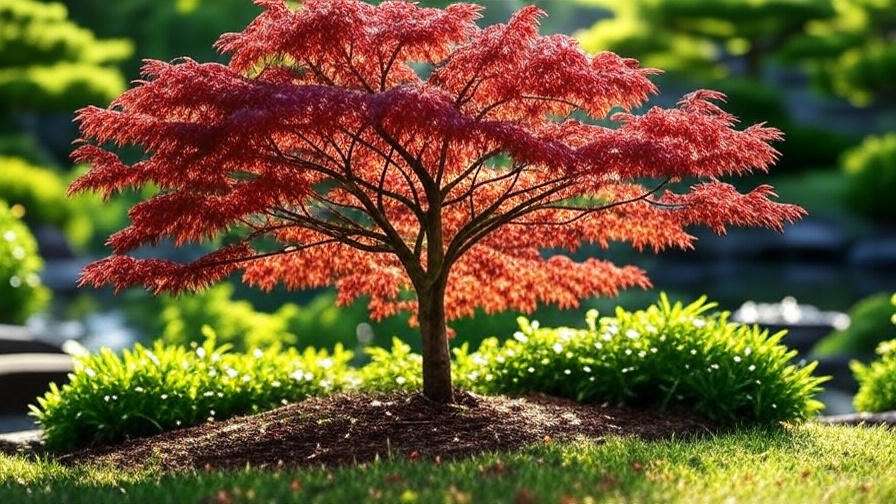
Remember, while this tree is relatively low-maintenance, it still requires attention to thrive. With patience and the right care, you’ll enjoy its stunning foliage and graceful form for many years to come. So, start implementing these tips today, and watch your miniature Japanese maple tree flourish with vibrant colors through every season!
Happy gardening, and may your tree grow strong and beautiful!
Frequently Asked Questions(FAQ)
How big does a miniature Japanese maple tree get?
A miniature Japanese maple tree typically grows to a height of 4-10 feet, making it perfect for small gardens, patios, or indoor spaces. Its compact size allows it to fit in tight spots while still providing vibrant colors and a beautiful shape.
How often should I water my miniature Japanese maple tree?
Water your miniature Japanese maple regularly to keep the soil moist but not soggy. During dry spells, ensure the tree receives water once a week. Avoid overwatering as it can lead to root rot. If the soil feels dry to the touch, it’s time to water.
Can I grow a miniature Japanese maple tree indoors?
Yes, you can grow a miniature Japanese maple indoors as long as it gets sufficient light. Place it near a window where it can receive bright, indirect light for at least 4-6 hours a day. Be sure to provide a well-draining potting mix and maintain consistent moisture.
When is the best time to prune a miniature Japanese maple tree?
The best time to prune your miniature Japanese maple is in late winter or early spring before the tree starts its new growth. This will help avoid damaging new shoots and encourage a healthy structure. Focus on removing dead, damaged, or crossing branches to promote better airflow.
Why are the leaves on my miniature Japanese maple tree turning brown or scorched?
Browning or scorched leaves are often caused by too much direct sunlight or underwatering. These trees prefer partial shade, so ensure it’s planted in a location that gets filtered light. If the tree is in direct sun, move it to a shaded area or provide some afternoon shade to protect the leaves.
What type of soil is best for a miniature Japanese maple tree?
Miniature Japanese maples prefer well-draining, slightly acidic soil with a pH between 5.5 and 6.5. A mixture of potting soil, perlite, and organic matter will provide the right balance for optimal growth. Avoid heavy, clayey soils that may cause waterlogging.
How do I protect my miniature Japanese maple tree during the winter?
To protect your tree during winter, mulch around the base to insulate the roots. If you live in a region with harsh winds, use burlap or other windbreaks to protect the branches. Additionally, make sure to water the tree well before the first freeze to ensure it has enough moisture during dormancy.
Why is my miniature Japanese maple tree not growing well or producing vibrant colors?
Poor growth or lack of color could be due to insufficient sunlight, improper watering, or poor soil quality. Ensure your tree is planted in a location with partial shade, water consistently, and use a balanced fertilizer to promote healthy growth and vibrant fall colors.

